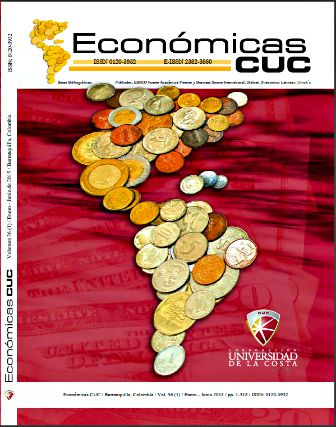Pensamiento estratégico: centro neurálgico de la planificación estratégica que transforma la visión en acción / Strategic thinking: the nerve center of strategic planning transforming vision into action
Keywords:
Strategic Thinking, Strategic Planning, Action, VisionAbstract
This reflection study is to analyze how strategic thinking becomes a valuable tool for organizational strategic planning, so that it allows the company to achieve its objectives and solve problems within a particular contextual framework. The methodology used in the research is documentary, with bibliographic support and analysis of information from authors like Cendrós, Fred, Morrisey, among others. For strategic thinking this is not only the starting point of the plan but its object. It is action with direction. It can be concluded that strategic thinking is the main aspect of what is strategically planned by the organization, it leads to the achievement of significant progress, it explores the capacity of innovation, competitiveness and transforms into action what in the planning is just the vision.
http://dx.doi.org/10.17981/econcuc.36.1.2015.26
Downloads
References
Arellano, D. (2004). Gestión estratégica para el sector público. Recuperado de: http://www.redalyc.org/articulo. oa? id=13314206
Boland, L. (2007), Funciones de la administración. Bogotá: Editorial Mc Graw Hill Interamericana S.A.
Burgwal, G. (1999). Planificación estratégica y operativa, aplicada a gobiernos locales. Quito: Abya Yala Publicaciones.
Castañeda, L. (2001). Pensar: tarea esencial de líderes y gerentes: Aplicación del Pensamiento Multimodal a la toma de decisiones y la solución de problemas organizacionales. Ciudad de México: Panorama Editorial.
Cendrós, J. (2001). Pensamiento Estratégico. Ensayos. Colección Gerencia de la Universidad Rafael Belloso Chacín. Maracaibo: Ediciones Gato Azul.
De León, L. (2000). Pensamiento estratégico, Planeación y Dirección Estratégica. La Habana: Universidad de Cienfuegos.
Dolan, S. & García, S. (2000). Managing by Values in the Next Milenium: Cul- tural Redesign for Strategic Organizational Change. Recuperado de: http:// www.econ.upf.es/deehome/what/wpa- pers/postscripts/486.pdf
Fred, D. (2006). Conceptos de Administración Estratégica. Novena edición. México: Editorial Printice Hall Hispanoamericana, S.A.
García, E. (2008). La Prospectiva en Cuba y su Vinculación con los Esfuerzos de Integración Latinoamericana, Observatorio Cubano de Ciencia y Tecnología. Recuperado de: http://issuu. com/metadata/docs/prospecal/199
Garrido, F. (2007). Pensamiento estratégico. La estrategia como centro neurálgico de la empresa. Barcelona: Ediciones Deusto.
Gimbert, X. (2006). El enfoque estratégico de la empresa: principios y esquemas básicos. Madrid: Edición. Deusto SA.
Gómez, P. (2009). Planificación Estratégica en Organizaciones no Lucrativas. Madrid: Editorial Narcea S.A. Ediciones.
Iglesias, A. (2004). El Planteamiento Estratégico de las Organizaciones Púlicas, una visión desde la teoría de caos. Universidad Rey Juan Carlos. Madrid: Editorial Dykinson.
López, M. (2005). Planeación estratégica de tecnologías informáticas y sistemas de información. Ciudad de México: Editorial Narcea.
Mintzberg, H. (2007). Planeación Estratégica. España: Ediciones Díaz de Santos.
Morrisey, G. (1996). Pensamiento Estratégico. Construya los cimientos de su planeación. Ciudad de México: Editorial Prentice Hall Hispanoamericana.
Navajo, P. (2009). Planificación Estratégica en Organizaciones No Lucrativas. Madrid: Narcea, S.A. de Ediciones.
Ocaña, J. (2006). Pienso luego mi empresa existe. San Vicente: Editorial Club Universitario.
Piñeiro, A. (2007). Pensamiento Estratégico y eficiencia de la Gerencia Pública en las Corporaciones Locales. Negotium, 3(008), 133-156
Seijo, C. & Ávila M. (2009) Valores éticos y responsabilidad social empresarial: una plataforma gerencial en universidades privadas. Revista Redhecs. 6(4), 26-40.
Serna, H. (1999). Gerencia Estratégica. Planeación y Gestión – Teoría y Metodología (6 Ed.). Colombia: 3R Editores.
Soderquist, D. (2005). El Estilo WalMart. EEUU: Caribe Betania Editores. Editorial Caribe, Inc. U.S.A
Downloads
Published
How to Cite
Issue
Section
License
You are free to:
- Share — copy and redistribute the material in any medium or format
- The licensor cannot revoke these freedoms as long as you follow the license terms.
Under the following terms:
- Attribution — You must give appropriate credit , provide a link to the license, and indicate if changes were made . You may do so in any reasonable manner, but not in any way that suggests the licensor endorses you or your use.
- NonCommercial — You may not use the material for commercial purposes .
- NoDerivatives — If you remix, transform, or build upon the material, you may not distribute the modified material.
- No additional restrictions — You may not apply legal terms or technological measures that legally restrict others from doing anything the license permits.


 English
English
 Español (España)
Español (España)














